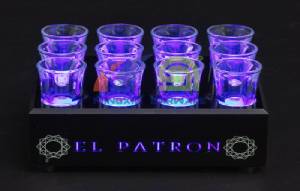E-mail: jasmine@mingxinbarnclub.com
LED ice bucket supplier to share with you: ACRYLIC, also known as PMMA or acrylic, acrylic.
The chemical name is polymethyl methacrylate. Derived from English Organic Glass, it means PMMA board made of organic compound MMA, its transparency and light transmittance are like glass. Acrylic is an important thermoplastic that was developed earlier.
Acrylic products include acrylic boards, acrylic plastic granules, acrylic light boxes, signboards, acrylic bathtubs, acrylic artificial marble, acrylic resins, acrylic (latex) lacquers and many other products. Acrylic products that people commonly see are acrylic products that are assembled from raw materials such as acrylic pellets, plates or resins through various processing methods, and with various parts and materials of different functions. As for the commonly used acrylic fiber, acrylic cotton, acrylic yarn, acrylic nylon, etc., it refers to the artificial fiber made of acrylic polymer, which is not related to acrylic products.
Second, the main uses of acrylic materials
PMMA has the advantages of light weight, low price, and easy molding. Its molding methods include casting, injection molding, machining, and thermoforming. In particular, injection molding can be mass-produced, the process is simple, and the cost is low. Therefore, its application is becoming more and more extensive, and it is widely used in instrumentation parts, automotive lights, optical lenses, transparent pipes, etc.
Application areas:
1.Architectural applications: display windows, soundproof doors and windows, lighting covers, telephone booths, etc.
2.Advertising applications: light boxes, signs, signs, display stands, etc.
3.Transportation applications: trains, cars and other vehicles doors and windows
4. Medical applications: baby incubators, various surgical medical appliances, civilian goods: bathroom facilities, crafts, cosmetics, brackets, aquariums, etc.
5. Industrial applications: instrument surface boards and covers, etc.
6. Lighting applications: fluorescent lamps, chandeliers, street lamp covers, etc.
Application areas: hotels, shopping malls, office buildings, clubs, villas, museums, medical, education, catering, exhibitions, etc.
Application area: suspended ceiling, integrated suspended ceiling, partition, screen, sliding door, transparent wall, LED acrylic serving tray, office furniture, bar, lighting, pendant lamp, logo,
First, what is acrylic
signage, floor, landscape, etc.

Led Acrylic Serving Tray
Advantages and disadvantages of acrylic materials
Advantages: Acrylic is the best new material that can make sanitary ware after ceramics. Compared with traditional ceramic materials, in addition to its unparalleled high brightness, acrylic also has the following advantages: good toughness, not easy to break; strong repairability, as long as you use a soft foam dipped in toothpaste to wipe the sanitary ware; soft texture, winter There is no icy feeling; the color is bright, which can meet the individual pursuit of different tastes. The use of acrylic to make basins, bathtubs, and toilets is not only exquisite in style, durable, but also environmentally friendly. Its radiation is almost the same as that of the human body's own bones. Acrylic sanitary ware first appeared in the United States and has occupied more than 70% of the entire international market.
Disadvantages: Due to the difficulty and high cost of acrylic production, there are many low-cost and high-quality substitutes on the market. These substitutes are also called "acrylic", which are actually ordinary organic boards or composite boards (also known as sandwich boards). Ordinary organic boards are cast with ordinary plexiglass cracking materials and pigments. The surface hardness is low, and it is easy to fade. The polishing effect is poor after grinding with fine sand. The composite board has only a thin layer of acrylic on the surface and ABS plastic in the middle. It is easy to delaminate under the influence of thermal expansion and contraction during use. True and false acrylic can be identified from the slight color difference and polishing effect of the cross section of the board.
Copyright © MingXin Barware Co., Limited All Rights Reserved. | Sitemap